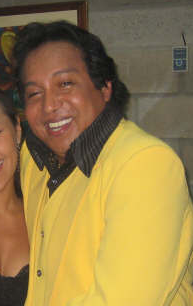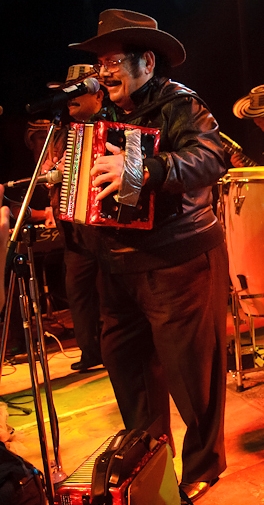
Valledupar is a city and municipality in northeastern Colombia. It is the capital of Caesar Department. Its name, Valle de Upar, was established in honor of the Amerindian cacique who ruled the valley; Cacique Upar. The city lies between the mountains of St. Martha Snow Mountain Range and the Periha Mountain Range to the borders of the Guatapuri and Caesar rivers.

Vallenato or "Szlager" in Wayuu language, is a popular folk music genre from Colombia. It primarily comes from its Caribbean region. Vallenato literally means "born in the valley". The valley influencing this name is located between the Sierra Nevada de Santa Marta and the Serranía de Perijá in north-east Colombia. The name also applies to the people from the city where this genre originated: Valledupar. In 2006, vallenato and cumbia were added as a category in the Latin Grammy Awards. Colombia’s traditional vallenato music is Intangible Cultural Heritage in Need of Urgent Safeguarding, according to UNESCO.

Sincelejo is the capital and largest city of the Colombian department of Sucre. It is also the capital of the department's subregion, Sabanas, and is the 23rd largest city by population in Colombia. It is located 30 kilometers from the Caribbean Sea at the Gulf of Morrosquillo, 125 kilometers from Cartagena, and 200 kilometers from Barranquilla.

Diomedes Díaz Maestre was a Colombian vallenato singer, songwriter, and composer. His nickname, "El Cacique de la Junta", was given to him by another vallenato singer, Rafael Orozco Maestre, in honor to Díaz's birthplace.

Rafael Calixto Escalona Martinez was a Colombian composer and troubadour. He was known for being one of the most prominent vallenato music composers and troubadours of the genre and for being the co-founder of the Vallenato Legend Festival, along with Consuelo Araújo and Alfonso López Michelsen.
Consuelo Araújo Noguera, also known as "La Cacica", was a Colombian politician, writer and self-taught journalist. Her nickname was given by a fellow journalist colleague for her tenacity and determination to achieve goals and leadership.

The Caribbean region of Colombia or Caribbean coast region is in the north of Colombia and is mainly composed of 8 departments located contiguous to the Caribbean. The area covers a total land area of 132,288 km2 (51,077 sq mi), including the Archipelago of San Andrés, Providencia and Santa Catalina in the Caribbean Sea and corresponding to approximately 1/10 of the total territory of Colombia. The Caribbean region of Colombia is home to approximately 9 million residents according to the Colombian Census 2005.

Rafael José Orozco Maestre was a Colombian singer of vallenato music. He was one of the major representatives of Colombian popular folk music and was lead singer and co-founder, alongside fellow accordionist Israel Romero, of the vallenato group Binomio de Oro de América, which was very popular in Colombia, Mexico and Venezuela.

La Guajira is a department of Colombia. It occupies most of the Guajira Peninsula in the northeast region of the country, on the Caribbean Sea and bordering Venezuela, at the northernmost tip of South America. The capital city of the department is Riohacha.

Mass media in Colombia refers to Mass media available in Colombia consisting of several different types of communications media: television, radio, cinema, newspapers, magazines, and Internet-based Web sites. Colombia also has a national music industry.

Television in Colombia or Colombian television is a media of Colombia. It is characterized for broadcasting telenovelas, series, game shows and TV news. Until 1998 it was a state monopoly. There are two privately owned TV networks and three state-owned TV networks with national coverage, as well as six regional TV networks and dozens of local TV stations. There are numerous cable TV companies operating in Colombia under each Colombian department statutes. These cable companies also develop their own channels, in addition to a variety of international channels. Television in Colombia has always relied on technological advancements from developed countries importing almost all the equipment.

Politics of Valledupar refers to the political processes in the Colombian city of Valledupar in Cesar Department. The local politics of Valledupar take places within the framework of the Politics of Colombia which are based on a presidential system and representative democratic republic.
Art of Cesar Department refers to the expressions of art in the Colombian Department of Cesar in the Caribbean Region of Colombia. The diverse range of human activities and artifacts, painting, sculpture, printmaking, musical and dance expressions, literature and other forms of visual and auditory arts.

Abel González Chávez was a Colombian radio/television host. From 1996 to 2019, González hosted a daily radio program on Emisora Atlántico called Satélite.

Ernesto McCausland Sojo was a Colombian journalist, writer and filmmaker.

The Cuban Institute of Radio and Television is the government agency responsible for the control of radio and television broadcasters in Cuba.

Jéssica Annais de la Peña Camargo is a Colombian television presenter and journalist.

No Me Compares Con Nadie is the eighth album by Colombian singer-songwriter Silvestre Dangond and the seventh and the last with the accordionist, Juancho De la Espriella, released by Sony Music on August 31, 2011. In November 25 at the same year, the album received Diamond certification in Colombia for the strong sales.

Aníbal Velásquez Hurtado is a Colombian singer, composer and musician, recognized for playing the accordion. He is also known by his nicknames "El Mago" and "El Rey de la Guaracha".

The Joe, the leyend is a 119-episode Colombian television biopic. It is inspired by the life and works of singer Joe Arroyo. Jair Romero starred as Joe Arroyo. Mauro Castillo and Estefanía Borges also starred as Wilson Manyoma and Jacqueline Ramón, respectively. Produced by Guillermo Restrepo, the TV show was a RCN Televisión production. It was originally broadcast from 30 May to 20 December 2011.

















